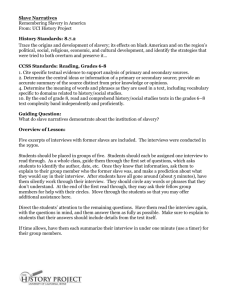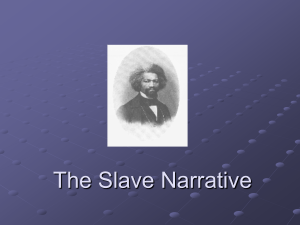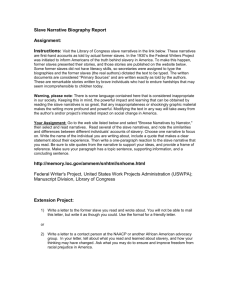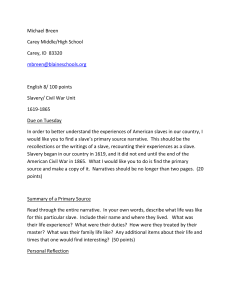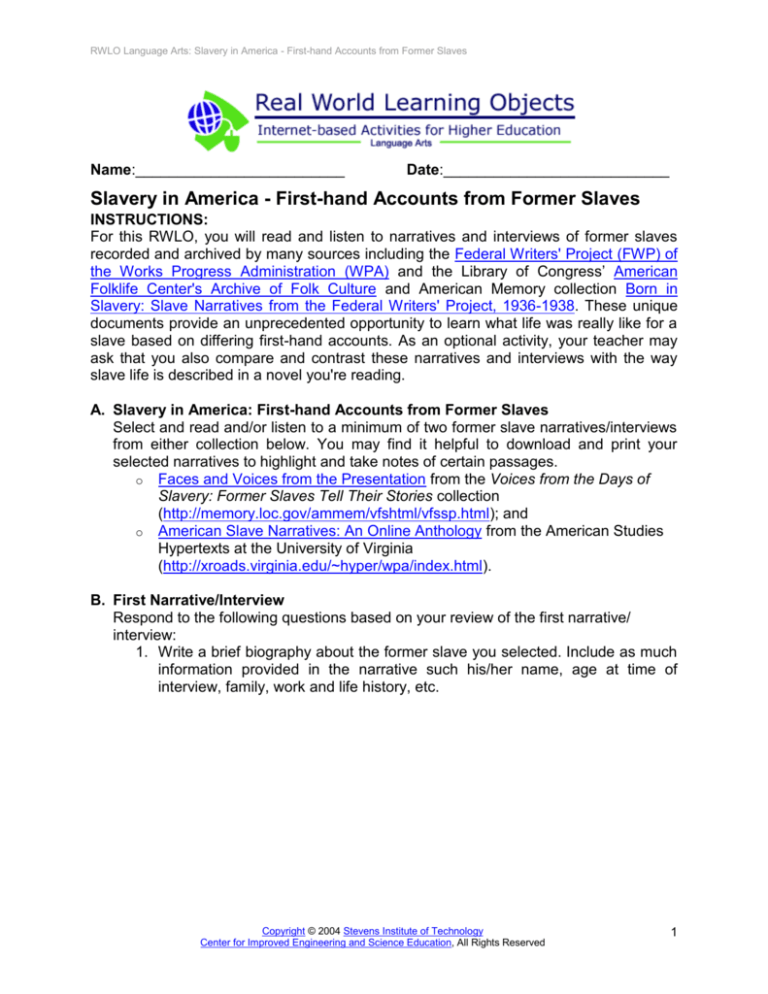
RWLO Language Arts: Slavery in America - First-hand Accounts from Former Slaves
Name:_________________________
Date:___________________________
Slavery in America - First-hand Accounts from Former Slaves
INSTRUCTIONS:
For this RWLO, you will read and listen to narratives and interviews of former slaves
recorded and archived by many sources including the Federal Writers' Project (FWP) of
the Works Progress Administration (WPA) and the Library of Congress’ American
Folklife Center's Archive of Folk Culture and American Memory collection Born in
Slavery: Slave Narratives from the Federal Writers' Project, 1936-1938. These unique
documents provide an unprecedented opportunity to learn what life was really like for a
slave based on differing first-hand accounts. As an optional activity, your teacher may
ask that you also compare and contrast these narratives and interviews with the way
slave life is described in a novel you're reading.
A. Slavery in America: First-hand Accounts from Former Slaves
Select and read and/or listen to a minimum of two former slave narratives/interviews
from either collection below. You may find it helpful to download and print your
selected narratives to highlight and take notes of certain passages.
o Faces and Voices from the Presentation from the Voices from the Days of
Slavery: Former Slaves Tell Their Stories collection
(http://memory.loc.gov/ammem/vfshtml/vfssp.html); and
o American Slave Narratives: An Online Anthology from the American Studies
Hypertexts at the University of Virginia
(http://xroads.virginia.edu/~hyper/wpa/index.html).
B. First Narrative/Interview
Respond to the following questions based on your review of the first narrative/
interview:
1. Write a brief biography about the former slave you selected. Include as much
information provided in the narrative such his/her name, age at time of
interview, family, work and life history, etc.
Copyright © 2004 Stevens Institute of Technology
Center for Improved Engineering and Science Education, All Rights Reserved
1
RWLO Language Arts: Slavery in America - First-hand Accounts from Former Slaves
2. How does he/she describe daily life as a slave?
3. How does he/she describe the working and living conditions at the time?
4. How does he/she describe freedom? For example, what did he/she do
differently? what was the experience like?, etc.
5. What was the most compelling or interesting thing you discovered about the
person's life? Why?
Copyright © 2004 Stevens Institute of Technology
Center for Improved Engineering and Science Education, All Rights Reserved
2
RWLO Language Arts: Slavery in America - First-hand Accounts from Former Slaves
C. Second Narrative/Interview
Respond to the following questions based on your review of the second narrative /
interview:
1. Write a brief biography about the former slave you selected. Include as much
information provided in the narrative such his / her name, age at time of
interview, family, work and life history, etc.
2. How does he/she describe daily life as a slave?
3. How does he/she describe the working and living conditions at the time?
4. How does he/she describe freedom? For example, what did he/she do
differently? what was the experience like?, etc.
Copyright © 2004 Stevens Institute of Technology
Center for Improved Engineering and Science Education, All Rights Reserved
3
RWLO Language Arts: Slavery in America - First-hand Accounts from Former Slaves
5. What was the most compelling or interesting thing you discovered about the
person's life? Why?
D. Differing Accounts
Respond to the following questions based on your review of each of the selected
narratives/interviews:
1. What aspect or aspects of slavery were shared by these men and women? Cite
examples.
2. What aspect or aspects of slavery were different by these men and women? Cite
examples.
3. OPTIONAL: How do these narratives and interviews compare or contrast with the
way slave life is described in the novel you're reading? List at least two (2)
similarities and two (2) differences.
SIMILARITIES:
1.
2.
DIFFERENCES:
1.
2.
Copyright © 2004 Stevens Institute of Technology
Center for Improved Engineering and Science Education, All Rights Reserved
4

